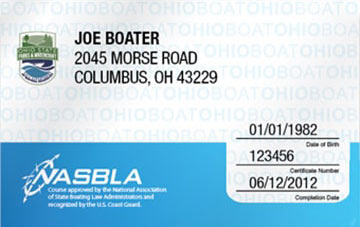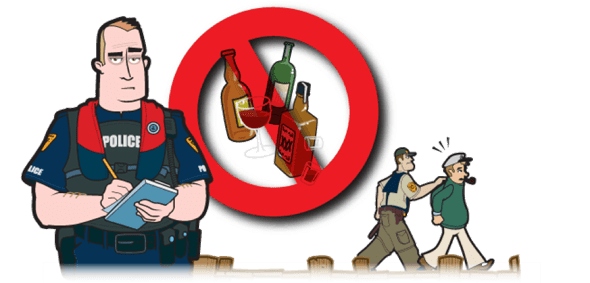OhioBoating
Laws & Regulations
Who needs to take the Ohio boaters safety course?
All boaters born after December 31, 1981 must have an Ohio Boater Education Certificate to operate any motorized watercraft over 10 HP. BOATERexam.com® is a delegated provider for the Ohio Department of Natural Resources, Division of Watercraft.
Returning user? Log in here

Approved by the
Ohio Department of Natural Resources, Division of Watercraft

Good for life!
Get your official
Ohio Boating License
Ohio Boating Safety Requirements

Personal Flotation Devices (PFDs aka Life Jackets)
- Ohio boaters are required to carry at least one U.S. Coast Guard approved Type IV PFD (ring buoy OR seat cushion) on all vessels that are 16 feet in length or greater, plus a wearable PFD for each person on board.
- No person shall ride or attempt to ride upon water skis, surfboards, inflatable devices or similar devices being towed by a vessel without wearing a U.S. Coast Guard approved Type I, II, or III PFD or a Type V PFD specifically designed for water-skiing, in good and serviceable condition, and of appropriate size. No operator of a vessel shall tow any person who fails to comply with this law.
- All PWC operators and occupants must be wearing a Type I, II, III or V personal flotation device.
- All vessels less than 16 feet in length as well as canoes or kayaks of any length are required to have one Type I, II or III wearable PFD per person.
- Inflatable PFDs are not intended for children under the age of 16 years.
PFD Law for Children
All boaters or passengers younger than 10 years of age onboard a vessel less than 18 feet in length must be wearing a U.S. Coast Guard approved PFD.

Alcohol & Boating Under the Influence (BUI)
A boat operator with a blood alcohol content (BAC) of .08% or more is considered to be intoxicated and operating under the influence (OUI). Ohio law establishes the following penalties for boating while intoxicated:
| Penalty for Operating Under the Influence of Alcohol or Drugs | ||
|---|---|---|
| Offense | Minimum | Maximum |
| First | 3 days jail; $150 fine | 6 months in jail; $1,000 fine |
| Second | 10 days jail; $150 fine | 6 months in jail; $1,000 fine |
| Third | 30 days jail; $150 fine |
Up to 1 year in jail; $1,000 fine |
By operating a vessel on Ohio waters, you have consented to an alcohol test if asked by a law enforcement officer. Refusal to undergo testing is an offense in itself and may lead to a loss of operating privileges for up to one year as well as fines.
"Zero Tolerance" prohibits persons younger than 21 years of age from consuming alcohol and operating a vessel with any measurable alcohol level at or above 0.02%.

Ohio Boat Registration
The Ohio Department of Natural Resources, Division of Watercraft regulates the state boating laws in Ohio.
Numbering and registering a watercraft are two separate functions. Boaters cannot operate any watercraft without a valid registration. Evidence of registration is shown by displaying two square tags or one rectangular tag (Alternative Registration for watercraft propelled by human muscular effort), and carrying the valid registration certificate on board the watercraft.
All watercraft principally operated on Ohio waters must be registered and issued an Ohio Registration Certificate by the Ohio Division of Parks & Watercraft.
The following vessels do not require registration:
- Vessels which are not required to be numbered, excluding documented watercraft;
- Watercraft which are properly registered in another state and operating the waters of Ohio for less than 60 days consecutively;
- Commercial vessels; and
- "Bellyboats"/"float tubes", kiteboards, paddleboards and sailboards.
New owners of a used watercraft must transfer the registration before operating the watercraft. To transfer the registration, simply ask the previous owner to complete the 'transfer' section and bring the registration certificate (even if not expired) to any watercraft registration agent. If a watercraft requiring a title is transferred to a new owner, the watercraft may be operated for up to 45 days before being titled in the new owner's name provided the new owner carries either of the following onboard:
- A temporary watercraft registration from an authorized registration agent; or
- A bill of sale from a watercraft dealer containing the required information.
*Registration Certificates and tags are valid for up to 3 years and expire on March 1st of the year indicated.

Certificate of Title
Boat owners must first obtain their boat title before a certificate of registration can be issued. A boat title is obtained from any county title office. The following watercraft require a title in the state of Ohio:
- All watercraft 14 feet or more in length; and
- All watercraft less than 14 feet in length, which are permanently fitted with a motor of 10 horsepower or more.
Note: Outboard motors that are 10 horsepower or more are also required to be titled.
Some watercraft listed above and on the previous page may not have needed a title when it was originally purchased. Prior to selling the watercraft, however, the owner must apply to a title office and obtain a title.
These include:
- Watercraft or outboards purchased on or before October 9, 1963; and
- Watercraft less than 14 feet in length with a permanently affixed mechanical means of propulsion of 10 horsepower or greater and purchased on or before January 1, 2000.
The following watercraft do not require a Certificate of Title:
- U.S. Coast Guard documented watercraft
- Watercraft owned by federal, state or a political subdivision of a state
- Canoes and kayaks
- Motors which are less than 10 horsepower
- Watercraft from another country
- Watercraft less than 14 feet in length without a permanently affixed mechanical means of propulsion;
- Watercraft less than 14 feet in length with a permanently affixed mechanical means of propulsion of less than 10 horsepower; and
- A ship's life boat

Personal Watercraft Laws & Regulations
Do not underestimate a personal watercraft (PWC) – they are very powerful for their small size and demand the same respect as any boat. In fact, PWC operation must adhere to the same rules and regulations as any other powerboat, including registration with the state and a B-1 class fire extinguisher aboard. There are additional requirements in Ohio for PWC operation:
Hours of Operation
No person shall operate a personal watercraft between sunset and sunrise.
Lanyard Requirementn
A person operating a personal watercraft that is equipped by the manufacturer with a lanyard-type engine cut-off switch, must attach the lanyard to the person, the person's clothing, or personal flotation device as appropriate for the specific watercraft.
PFD Requirement
No person shall operate or permit the operation of a personal watercraft unless each person on the watercraft is wearing a Type I, II, III or V PFD at all times. Remember: Inflatable PFDs are NOT intended for use with PWC.
"No-wake" speed
PWC must operate at "no-wake" speed when in designated "no-wake" zones or shore zones.
No person who owns or has charge over a personal watercraft shall permit operation in violation of laws.
Boating on Lake Erie
Lake Erie is one of Ohio's most popular recreational boating locations. There are certain considerations when boating on Lake Erie that boaters must be aware of.
Remember to keep at least 100 yards from U.S. Naval vessels, which are occasionally found on the Great Lakes. You are also required to reduce to "no wake" speed when operating within 500 yards of such vessels. If for any reason you need to approach within 100 yards of a Naval vessel, you are required to contact either the vessel or the US coast guard before doing so, on channel 16 of your VHF-FM radio. Failure to do so is a felony offence.
Lake Erie borders Canada. As such, boaters who cross into Canadian waters must report for customs inspection. ALL boaters and passengers will require a valid photo ID as well as a passport or a birth certificate. For further information, call Canadian Customs at 1-888-226-7277.
All boats entering the United States from Canadian waters that have passengers who were on Canadian soil must report to U.S. Customs. This legal obligation may be met by telephone. You can call on route with a cellular phone or immediately upon arrival to the United States.
Have the following information ready when calling to avoid delays:
- Boat registration number and length (and Customs decal if over 30 feet; see below),
- Captain's name and date of birth,
- Total number of persons on board and value of all purchases in Canada,
- The name of the marina where you first arrived on the United States side.U.S.
Customs and Border Protection has offices in Ashtabula (440-964-2510), Cleveland (440-891-3800), and Toledo/Sandusky (419-259-6424).